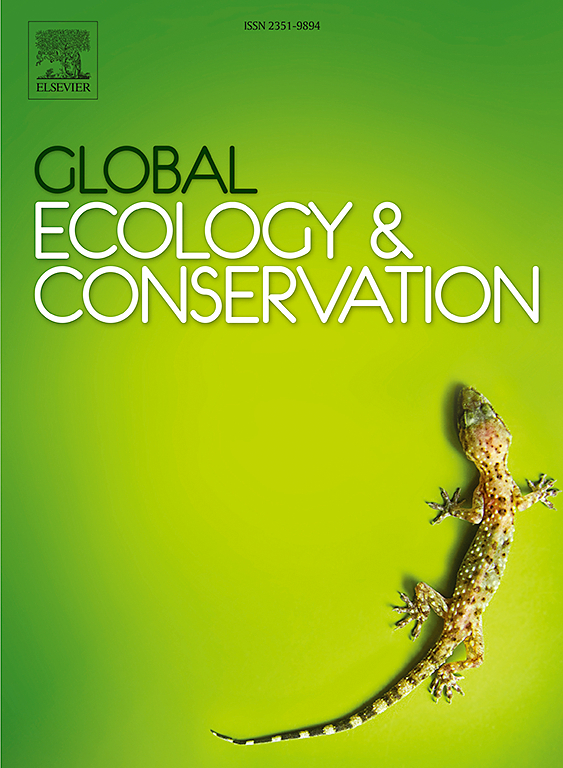Herbivory and fire influence soil and plant nutrient dynamics in Chitwan National Park, Nepal
IF 3.4
2区 环境科学与生态学
Q1 BIODIVERSITY CONSERVATION
引用次数: 0
Abstract
In the context of global biodiversity loss and climate change, understanding how herbivores and fire shape plant-soil nutrient dynamics across vegetation types has become a global priority. In tropical Asia, the combined effects of herbivore assemblages, fire regimes, and plant community diversity on nutrients remain poorly understood. We investigated how herbivory and fire influence soil nutrients (nitrogen (N), phosphorus (P), potassium (K), and cation exchange capacity (CEC)) and plant nutrients (N, P, K), across five vegetation types - two forests (riverine, Shorea) and three grasslands (tall, short, grazing lawn) in Chitwan National Park, Nepal. Across 50 plots (400 m2 each), we quantified mammalian herbivory pressure using dung counts, fire frequency using satellite data, and analyzed 150 soil and 187 plant samples for nutrient concentrations. Herbivore dung and fire frequency varied markedly across habitats: herbivores were largely absent from tall grasslands while present in all other vegetation types, whereas fires were rare in short grassland and grazing lawns but frequent in tall grassland and forests. Overall, forests had higher soil and plant nutrient concentrations than grasslands. Soil N, K, and CEC increased with increasing dung counts across vegetation types, whereas plant K decreased with increasing dung counts only in Shorea forests and grazing lawns. Soil P and CEC increased, while plant N, P and K decreased with increasing fire frequency across vegetation types. For the two forest types, interactions between dung and fire counts decreased soil P, plant N and plant P in riverine forest but had no effect in Shorea forest. These findings highlight the additive and interactive impacts of herbivory and fire on nutrient cycling, emphasizing the need to manage disturbance regimes to sustain soil fertility, habitat quality, and biodiversity resilience in tropical landscapes.
尼泊尔奇旺国家公园草食和火对土壤和植物养分动态的影响
在全球生物多样性丧失和气候变化的背景下,了解草食动物和火灾如何影响不同植被类型的植物-土壤养分动态已成为全球优先考虑的问题。在热带亚洲,草食动物组合、火灾制度和植物群落多样性对营养物质的综合影响仍然知之甚少。研究了尼泊尔奇旺国家公园5种植被类型——2种森林(河流森林、Shorea森林)和3种草地(高草地、矮草地和放牧草地)中,草食和火对土壤养分(氮、磷、钾和阳离子交换量)和植物养分(N、P、K)的影响。在50个样地(每个样地400 m2)中,我们利用粪便计数量化了哺乳动物的食草压力,利用卫星数据量化了火灾频率,并分析了150个土壤和187个植物样本的养分浓度。草食动物粪便和火灾发生的频率在不同的生境中差异显著:在高草地上基本上没有草食动物,而在所有其他植被类型中都有,而在矮草地和放牧草坪上很少发生火灾,但在高草地和森林中却很常见。总体而言,森林的土壤和植物养分浓度高于草原。土壤N、K和CEC随粪便数量的增加而增加,而植物K仅在海岸林和放牧草地随粪便数量的增加而减少。随着火灾频率的增加,土壤P和CEC增加,植物N、P和K减少。在两种林型中,粪火交互作用降低了河流林型土壤磷、植物氮和植物磷含量,但对赤潮林型没有影响。这些发现强调了草食和火对养分循环的附加和交互影响,强调了在热带景观中管理干扰制度以维持土壤肥力、栖息地质量和生物多样性恢复力的必要性。
本文章由计算机程序翻译,如有差异,请以英文原文为准。
求助全文
约1分钟内获得全文
求助全文
来源期刊

Global Ecology and Conservation
Agricultural and Biological Sciences-Ecology, Evolution, Behavior and Systematics
CiteScore
8.10
自引率
5.00%
发文量
346
审稿时长
83 days
期刊介绍:
Global Ecology and Conservation is a peer-reviewed, open-access journal covering all sub-disciplines of ecological and conservation science: from theory to practice, from molecules to ecosystems, from regional to global. The fields covered include: organismal, population, community, and ecosystem ecology; physiological, evolutionary, and behavioral ecology; and conservation science.
 求助内容:
求助内容: 应助结果提醒方式:
应助结果提醒方式:


